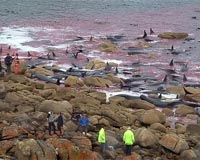| . |  |
. |
Long Beach, California (AFP) Jan 27, 2011 At the Aquarium of the Pacific, Michele Sousa is excited: the annual gray whale migration is in full swing, and it's a bumper year to view the lumbering leviathans off the California coast. The vast mammals -- an endangered species elsewhere, but apparently thriving in the eastern Pacific -- are being seen in healthy numbers as the females head south from Alaska to give birth in the warm waters of Mexico. There had been concerns over the last five years when numbers have been down, but experts are relieved to see them plowing south. "This season is off to a great start ... Since we started to take counts in early December we've seen over 264 gray whales and 14 calves," said Sousa, the senior mammal expert at the Aquarium on long beach, south of Los Angeles. There are thought to be up to 22,000 of the huge undersea beasts, which can reach lengths of up to 15 meters (yards) and weigh up to 35 tonnes, in the waters off the US Pacific coast. Every year pregnant female grays are first to make a dash thousands of miles from the icy northern waters off Alaska to the balmy lagoons of Baja California in Mexico, to give birth to their young. They are followed by singleton and younger whales -- who have a less urgent need to get south, but still make a respectable 160 kilometers (100 miles) a day, flicking their vast tails to thrust themselves southward. "The single whales, both males and females, will socialize quite a bit on the southward migration," said Kera Mathes, another whale expert at the non-profit Aquarium. "The pregnant females are trying to get to the lagoons as quickly as possible to keep the calves protected and in warm water, so we normally see the pregnant females go by first, then the singles, and lastly the juveniles." In all the gray whales make a round trip of 16,093 to 22,530 km (10,000 to 14,000 miles), starting with a two to three-month trip south from October, two to three months in the lagoons, then two to three months heading back north. "On the northbound migration, we typically see the newly pregnant females first, then the singles and juveniles, and then lastly the new cow/calf pairs," she added. The gray mammals -- named after their color, although coincidentally they were first classified by 19th-century British zoologist John Edward Gray -- are far from the only whale types seen off the coast here. Blue whales, Minke whales, and orcas live side-by-side with dolphins, sea lions and a host of other marine animals, in an area whose diversity is boosted by huge differences in seabed depth on the edge of the continental shelf. But the grays do have at least one claim to singularity: they are the only living species in their scientific genus, eschrichtius robustus. They can also be identified by boat-borne whale-watchers from the distinctive, some say heart-shaped, water spout they produce from their two blow holes, as they surface every few minutes. While the east Pacific grays seem to be doing well, a much smaller group of barely 130 is known about near South Korea, while they became extinct in the north Atlantic, although one was discovered in the Mediterranean last year. Alisa Schulman-Janiger of the American Cetacean Society, who has run a gray whale census with a lookout post on a headland north of Long Beach for three decades, confirmed the good news. "The last couple of years the population counts have been down, and so some people were saying, maybe the whole gray whale population itself is down. But this year it's back up," she said. "The counts up and down the coast are quite robust, and so I have no worries that the gray whale population at least on this side of the Pacific is in trouble. They seem to be doing really well. This is a good year." Back on the boat, which plies the waters a couple of miles off the coast of Long Beach, British tourist Paddy Mulcahy is enthralled by both the whales, and dolphins which leap along beside the vessel and in its wake. "The whole thing was terrific. It's really unusual to see something just up so close and personal. The dolphins, they're big enough, and then you see something as large as the whale ..Terrific the whole thing," he said.
Share This Article With Planet Earth
Related Links Follow the Whaling Debate
 New Zealand rangers put down stranded whales
New Zealand rangers put down stranded whalesWellington (AFP) Jan 21, 2011 New Zealand wildlife rangers put down 10 pilot whales stranded in a remote New Zealand bay Friday after reluctantly determining there was no way to save them, conservation officials said. The whales were the surviving members of a pod of 24 found early Friday trapped in mud and mangroves at Parengarenga Harbour, 320 kilometres (200 miles) northwest of Auckland, the Department of Conservation ... read more |
|
| The content herein, unless otherwise known to be public domain, are Copyright 1995-2010 - SpaceDaily. AFP and UPI Wire Stories are copyright Agence France-Presse and United Press International. ESA Portal Reports are copyright European Space Agency. All NASA sourced material is public domain. Additional copyrights may apply in whole or part to other bona fide parties. Advertising does not imply endorsement,agreement or approval of any opinions, statements or information provided by SpaceDaily on any Web page published or hosted by SpaceDaily. Privacy Statement |